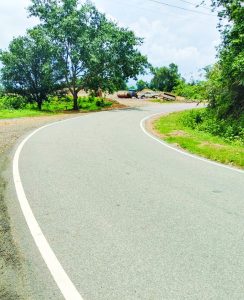From Our Correspondent

TURA, June 24: One of the most picturesque routes in the entire Garo Hills region, the Phulbari-Rongram road (Hill Road) had been a bone-crushing nightmare until just a year ago but thanks to a complete rehabilitation of the route, it has now become an absolute delight, barring only the sharp turns.
The road, which is only about 60 kms in length, connects Phulbari to Rongram before ending on the NH-51, making it the shortest route between Phulbari and the district headquarter of Tura, West Garo Hills.
The road also connects many important villages including Dadenggre, Rom and the historically significant, Sadolpara.
However, despite the short distance, the poor road condition made everyone wary of travelling on the route. Earlier, it took a minimum of three hours to travel between Phulbari to Rongram while even Dadenggre, just about 30 km away, took close to an hour and a half. The pothole-filled road was not only difficult to navigate but also dangerous to navigate, especially due to the short turns that encapsulated the entire route.
While the road has not changed much in terms of its twists and turns, it has become a joyride for many that now look at the road as one of the best short routes in the region, if not the entire state.
Currently, travel time between Phulbari to Rongram has reduced to about 1 hour 15 minutes though many take longer due to the scenic beauty one is graced with while using the route.
Giving credit where credit is due, the road, which has been executed by the Badri Rai & Company (BRC) in March 2021 and sanctioned from the state scheme, arguably provides the best travel experience. The project cost roughly about Rs 150 crore to make and it seems like money well used.
The project was duly completed and handed over in March 2024.
As to why it took three years to build a 60-km road, a highly placed company source said the challenges were huge and needed special adjustments. The almost entirely hilly terrain did not help matters.
“We initially tried to source materials locally but were stopped every time due to some or the other issues that came up. The terrain posed a major problem as was the lack of resources. There was a delay in the start of work. We then worked out that somehow we had to finish and do so quickly as thousands were dependent on it, without looking at profits,” said the source.
The BRC then began sourcing stones from Tangaon, a village close to Hallidayganj, and more than 80 km from the site of work.
“We employed a huge number of our dumpers and used the mobile-crushing unit; we had to ensure we had enough material to complete the road. Once that was worked out, the rest fell into place,” he added.
The completion, he informed, was very satisfying and was in line with how they were working on projects in the state and region.
“Even our Damra-Bajengdoba road is nearing completion and just awaits the deployment of the two bridges. You can check the quality of work done on that road as well,” informed the highly placed BRC source.
Talking about two other projects that the BRC has completed, the source stated that they only faced a hurdle in a three-km stretch between Garobadha to Selsella (out of 15 kms) only due to soil stratification issues. They are now using geotechnology to ensure the repairs last.
“We have completed the project more than 18 months ago but due to a problem with the soil, the stretch has become problematic. Though we have completed the defect liability period (one year), we are working on the stretch with new technology for water retention that will prevent the road breaking up, which will solve the problem. Even our Nokrek road (tourism) was handed over two years ago and has not reported any issues,” he added.



